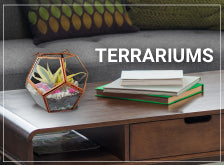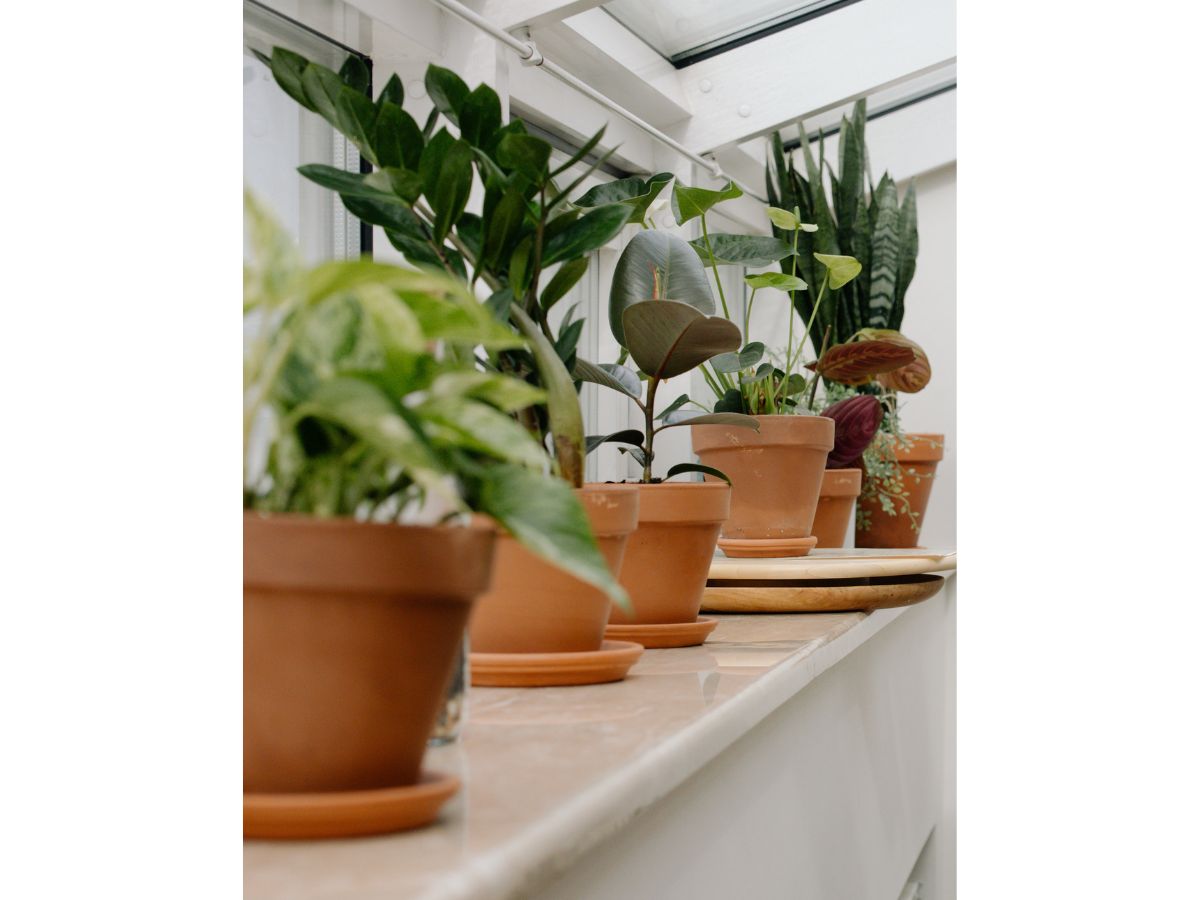How to Grow
Top Indoor Plants in India (Perfect for Indian Climate)
A Tulsi inside the home in the courtyard and a Neem and Banyan tree outside—this was the common sight in almost all homes. Fancy gardens are now uncommon to see in Indian households due to the diminishing amount of space caused by urbanization.
Experts advise bringing more indoor plants into the home due to recent incidents of smog and worrying AQI levels in major cities.
Today's time demands more indoor plants for your overall health. It is not that difficult to maintain indoor plants, as most of them are fuss-free ones.
We'll talk about the following in this blog:
- What are the advantages of keeping indoor plants?
- Which are the perfect indoor plants for Indian climate?
- Peace lily plant
- Lucky bamboo
- Snake plant
- Money plant
- Jade plant
- Aloe Vera
- Areca Palm
- African Violets
- Kalanchoe
- Rubber Plant
- Tulsi
It is going to be an exciting read. So, let’s get started.
What are the advantages of keeping indoor plants?
Why do you think there is a surge in plant-based podcasts, greenery-laced interior decoration, plant-filled home décor, and online plant delivery services? That’s because indoor plants can promote health and wellbeing and reduce pollution, which is on the rise. There are many more advantages of indoor plants mentioned below: -
Reduces stress levels
Working with plants nearby has been shown to lessen both physiological and psychological stress, according to researchers. You can feel more at ease, calm, and natural when they are around. Perhaps the presence of plants raises the oxygen level, which lowers stress levels.
Therapeutic for mental illness
Horticultural therapy has been utilized by researchers to improve well-being in patients with depression, anxiety, dementia, and other diseases. Anyone suffering from a mental condition may discover that gardening is therapeutic.
Happiness increases
You know how taking a walk in a park or garden may make you feel calmer, more in control of your thoughts, and less confused, depressed, or restless? This is because plants can promote relaxation. It is imperative that you consider your wellbeing now that the pandemic is over and you are spending 90% of your time indoors. Your happiness will grow if you bring indoor plants inside and take care of them, which will have a positive impact on other aspects of your life.
Better workplace
You would be astounded to learn the findings of one researcher who spoke with more than 400 Amazon employees in the US and India. It was discovered that those who work in offices with natural features like plants report more job satisfaction than people whose offices don't. Therefore, whether working from an office or from home, ensure that you are surrounded by plants for increased creativity and productivity.
Home décor
Plants are affordable in comparison to many opulent household furnishings. To make your home look more beautiful, place it in the middle of your coffee table, near a windowsill, above bookcases, or at the dining table.
Which are the perfect indoor plants for Indian climate?
India has a tropical monsoon climate. But this tropical climate has its regional variations. While in northern parts there is a humid tropical climate, the western coast has wet tropical areas. But hot and humid weather is characteristic of most of the regions. So, here is a list of indoor plants that will suit the Indian climate perfectly.
Peace lily plant
The most compelling reason to bring a peace lily plant today is because NASA has put it on its list of "Top Ten Household Air Cleaning Plants." This tropical shade-loving plant helps purify the air we breathe. Apart from cleaning the air, peace lilies are popular because they are low-maintenance plants. Peace lilies also symbolize peace, truce, and prosperity. It is a great gift for starting a new life.
Light: Medium or indirect light. But it can live without light too.
Water: Only when the topsoil has dried out.
Soil: It prefers a well-draining soil with good water retention. So, a peat moss and sand blend would be best.
Benefits: Promotes good sleep; Neutralizes toxic gases like carbon monoxide and formaldehyde; Removes mold spores from air.
Lucky bamboo
Lucky bamboo is one of the best indoor plants to keep at home because it doesn't need soil to flourish. It is a low-maintenance plant that may survive being neglected for days. The majority of people believe lucky bamboo to be a true bamboo plant. Not at all! It is a Dracaena sanderiana, a species of tropical water lily. Lucky bamboo is a popular Feng Shui plant that is believed to enhance good luck and prosperity.
Light: Indirect sunlight and light shade
Water: Use filtered rainwater or bottled water
Soil: If you are growing in soil, then opt for a nutrient-rich, acidic soil with a pH 6.0-6.5
Benefits: Brings good luck; Effectively purifies air; Increases oxygen in the air
Snake plant
The snake plant is also known as mother-in-law’s tongue or Sansevieria. They are native to Asia and Africa. Snake plants are often used as home decor since they’re pleasing to the eye, easy to care for, and require little water to survive. Cancer-causing pollutants such as formaldehyde, benzene, xylene, CO2, and others are effectively removed from the air by this plant.
Light: Any natural light is OK for the snake plant
Water: In winter, water it once every 2 months, and in the summer, once a week
Soil: A nutrient-rich soil with good drainage and good aeration is required.
Benefits: Minimizes toxins from air; Produces oxygen even at night; Promotes good sleep
Money plant
The money plant is one of the easiest-to-care-for houseplants that you can bring home. You can grow it in either water or soil. According to Vastu and Feng Shui, a money plant is considered lucky for the home as it contributes to the expansion of the house's finances. Bring a money plant home and adorn your balcony railings, window ceilings, etc. with it.
Light: Bright indirect light is perfect for the growth of the money plant
Water: Once a week
Soil: A well-draining soil like river sand mixed with normal potting soil
Benefits: Purifies air; Reduces stress & anxiety; Great anti-radiator; Helps clean aquarium water
Jade plant
The jade plant is native to South Africa and can thrive under mild climatic conditions. The fleshy leaves store water. It is one of the best low-maintenance plants that will filter your indoor air. The woody stems give a tree-like appearance.
Light: At least 6 hours of bright sunlight everyday
Water: Water once every 2-3 weeks or when the topsoil is dry
Soil: A well-draining, loose, rocky soil is best for jade plant
Benefits: Improves air quality at home; Heals wounds; Symbol of good luck & prosperity
Aloe Vera
The striking feature of this thick, short-stemmed shrub, Aloe vera, or Aloe barbadensis, is that it stores water in its leaves. Although it is primarily recognized for healing skin injuries, there are numerous additional uses for it that may be healthy. It can lower blood sugar levels.
Light: Bright indirect light is ideal for aloe vera plants
Water: Allow the soil to dry between waterings. Water every three weeks in the summer and even less frequently in the winter.
Soil: A loose, rocky soil that is well-draining
Benefits: Great for skin and hair; Has antioxidant and antibacterial properties; Heals wounds; Absorbs toxins from cleaning products, fuel, paints, woods, etc.
Areca Palm
Areca palm is a type of palm found in the Arecaceae family. It is native to the humid tropical forests of the islands of the Philippines, Malaysia, and India, across Southeast Asia to Melanesia. Apart from cleaning the air, areca palm plants bring beautification and decor value to your indoor setting. It combines beautifully with both contemporary and antique furnishings. The vibrant, long, green leaves are pleasing to the eyes.
Do you know that one 6 feet areca palm can transpire up to 946.35 ml of water every 24 hours?
Light: Partial sunlight works best for the growth of Areca Palm plants
Water: Check the top 2 inches of the soil first. If that is dry, feed water to Areca Palm plant
Soil: A porous, loose, and well-draining soil would be great for Areca palm. It may contain peat moss or sand.
Benefits: Removes toxins from air; Increases oxygen; Makes indoor air cooler
African Violets
The African violet houseplant is native to Tanzania. It is pretty famous as a houseplant all over the world. This plant will produce flowers all year if properly cared for. They have delicate, fuzzy leaves. They come in a variety of colors besides violet, including pink, red, blue, and white.
Light: Moderate light is best for its growth. You can also provide bright but indirect light.
Water: It loves moist but not soggy soil. So, water when the topsoil is dry.
Soil: An acidic and well draining soil is ideal for its growth. You can add sand or other porous materials to potting soil for this purpose.
Benefits: Non toxic to pets; Removes toxic byproducts from the air
Kalanchoe
Long-flowering perennial succulents, Kalanchoe plants are indigenous to Madagascar, where they flourish in arid conditions. The plant produces new flowers all round the year when you provide it proper sunlight. The best thing is that you can find a variety of colors of Kalanchoe – red, pink, yellow, and white. Isn’t it amazing to have some brightly colored flowers inside your home?
Light: Although prefers full sun but can thrive in partial shade too
Water: It loves thorough intermittent watering
Soil: An acidic, well-draining, light, and sandy soil is preferred.
Benefits: Nocturnal oxygenators; May boost sleep; Increases humidity; Reduces airborne dust levels
Rubber Plant
The other names for the Rubber Plant are Ficus elastica and Rubber Fig. It is a manageable plant that requires little maintenance to grow indoors. According to vaastu specialists, the rubber plant's rounded leaves are a symbol of prosperity and financial expansion. Do you know that the leaves of rubber plants are known to have natural anti-inflammatory properties? Therefore, the leaves might be able to relieve skin rashes. What else? The roots of the rubber plant are believed to help with rheumatic diseases.
Light: Bright but indirect light
Water: Once a week during the growing season, and for the rest of the time, wait for the topsoil to dry. Mist the leaves.
Soil: A well-draining and well-aerated potting soil
Benefits: Purifies air; Has anti-inflammatory properties; No pollen so won’t spread allergies
Tulsi
The most well-known plant in India is tulsi. Tulsi has been a popular indoor plant for its therapeutic benefits since ancient times. It is referred to as the "Queen of Herbs" with good reason. Experts in Vastu claim that the tulsi plant can eliminate all types of ailments and negative energies, boosting good energy and bringing you mental peace.
Light: 4-6 hours of direct sunlight
Water: Water when topsoil is dry but it may vary depending on claimate
Soil: A fertile loamy soil with good drainage and soil pH of 6-7.5
Benefits: Boosts immunity; Reduces cough, cold, and fever; Good for heart health; Reduces stress and blood pressure; Improves digestion; Improves skin & hair.
The majority of these indoor plants are low-maintenance and won't require much of your time. Pay attention to their minimal requirements and enjoy a better, healthier, and happier life in the company of these green buddies.
FAQ’s regarding indoor plants in India
Which indoor plant is best for your home?
Indoor plants that require low maintenance are best for homes. They increase the oxygen level inside the home and also elevate its beauty. The best indoor plants for homes are areca palms, aloe vera, peace lilies, snake plants, money plants, jade plants, lucky bamboo, kalachoe, tulsi, and African violets.
What is the best indoor plant to clean the air?
Almost all indoor plants can clean the air and provide you with a healthier atmosphere. Some of the most popular ones are: tulsi, snake plant, peace lily, areca palm, jade plant, and spider plant.
Which indoor plants are good for creativity?
Some indoor plants can boost your creativity, like lavender, golden pothos, fiddle leaf figs, and the magenta triostar.
Which indoor plants bring good luck?
According to experts, there are some plants that are linked to good luck. They are: lucky bamboo, money plant, rubber tree, snake plant, jade plant, tulsi, lavender, and citrus tree.
Ref Links: -
https://nurserylive.com/blogs/top-10-plants/top-10-indoor-flowering-plants-for-add-colors-in-your-interiors
https://indiagardening.com/indoor-gardening/indoor-plants-for-indian-climate/
https://www.wakefit.co/blog/common-house-plants-in-india/
https://www.housebeautiful.com/uk/garden/plants/a22048437/house-plants-cool-home-heatwave/
https://www.thesill.com/blog/why-you-need-plants-in-your-life
https://www.healthline.com/health/healthy-home-guide/benefits-of-indoor-plants#7-benefits
https://organicindiausa.com/blog/how-to-grow-tulsi/#:~:text=Like%20most%20other%20types%20of,warm%20temperatures%20and%20never%20frost
https://bloomboxclub.com/blogs/news/5-reasons-to-grow-rubber-plant-at-home#:~:text=The%20rubber%20plant%20has%20very,turn%20them%20into%20harmless%20compounds
https://www.kalanchoe.co.uk/2019/11/the-health-benefits-of-having-kalanchoes-in-the-home.html#:~:text=Kalanchoes%20are%20nocturnal%20oxygenators.,long%20cold%20nights%20set%20in.
https://www.fnp.com/article/interesting-facts-about-lucky-bamboo-plant
https://theindoornursery.com/blog/best-soil-for-snake-plants/



